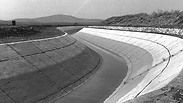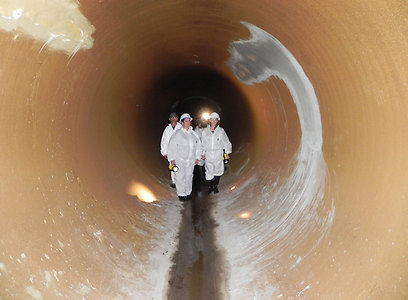
50 years later, National Water Carrier still an inspiration
Legacies of carrier are many, with system serving as model for less developed countries at risk of drought, offering possibilities for positive points of contact with Palestinians.
In a small private ceremony, the National Water Carrier was opened fifty years ago today. Despite the enormous cost of the system and the transformation of Israel’s infrastructure, Prime Minister Levi Eshkol was concerned that a public celebration could provoke a Syrian attack. Perhaps, then, the only low-key element of the Water Carrier was its opening.
Thinking about the National Water Carrier (NWC) began in April 1939, in response to the British White Paper limiting Jewish immigration on the grounds that there wasn’t enough water to grow food for a larger population. A brilliant water engineer, Simcha Blass, was charged by the Yishuv leadership with developing water resources to overcome the British objections.
Though the British would not be moved, the idea of taking water from the relatively water-rich north and bringing it to the south took root. After independence in 1948, David Ben-Gurion saw the transfer of Galilean water to the Negev as a national imperative. Intensive planning for the water line began at the same time as financing – much of it from German reparations – was lined up.
Getting support from American president Dwight Eisenhower for the plan was also essential to be sure of American backing if the water project provoked a conflict with Syria or Jordan.
Construction of the system began in 1959. The pipeline was a massive public works project for the still-poor nation. At its peak, one of every 14 able-bodied people in the country was digging, welding, pipefitting or otherwise working on the new water system. It cost about five percent of national GDP, an unfathomably large amount, and required invention of new engineering techniques.
The NWC succeeded in pushing the country’s inhabitable southern boundary from just south of Rehovot to now south of Beersheba. New immigrants could be settled on farms and a national agriculture economy – with billions in exports – established. As important, the system turned Israel’s water supply from a series of local or regional sources into a national system, an important element of nation building.
The legacies of the NWC are many. The expansion to the periphery continued and, in recent years, accelerated. Further, Israel is in the midst of large and challenging national infrastructure projects, including for railways, ports, oil and gas, and a re-directing of the national water system to account for the water now coming from desalination plants in the west to be blended with water from the north.
The courage and sacrifice of the nation in building the NWC can serve as an inspiration for these and other large projects.
The success of the NWC also offers possibilities for positive points of contact with the Palestinians today. Shortly before the National Water Carrier was inaugurated, Israeli Arabs in the Galilee, especially in Nazareth and Shafaram, protested being joined to the national water grid.
They were concerned that it would lead to a stripping away of their national identity. Clearly, it didn’t cause them to lose their communal distinctiveness, but, rather, to getting water on demand with the twist of a faucet. That they would receive the same quality water as other Israelis speaks to the idea that all citizens might receive similar benefits of a common national identity.
In a peace agreement, West Bank and Gaza Palestinians could agree to an integrated regional water system and not elevate water infrastructure to a symbol of sovereignty requiring a segregation of water interests or infrastructure.
A regional water system offering reliable, high-quality water as the National Water Carrier did for Israel could align the parties’ interests while removing water as a point of conflict. It could even deepen regional integration with some of Israel’s water-stressed neighbors.
And finally, as the world likely moves into a global water crisis, Israel’s National Water Carrier may be a model for those less developed countries most at risk that their own water woes can be reversed, as Israel did fifty years ago.
Seth M. Siegel, a member of the Council on Foreign Relations, is at work on a book about Israel’s water resources. He tweets about Israel water issues at @SethMSiegel.











